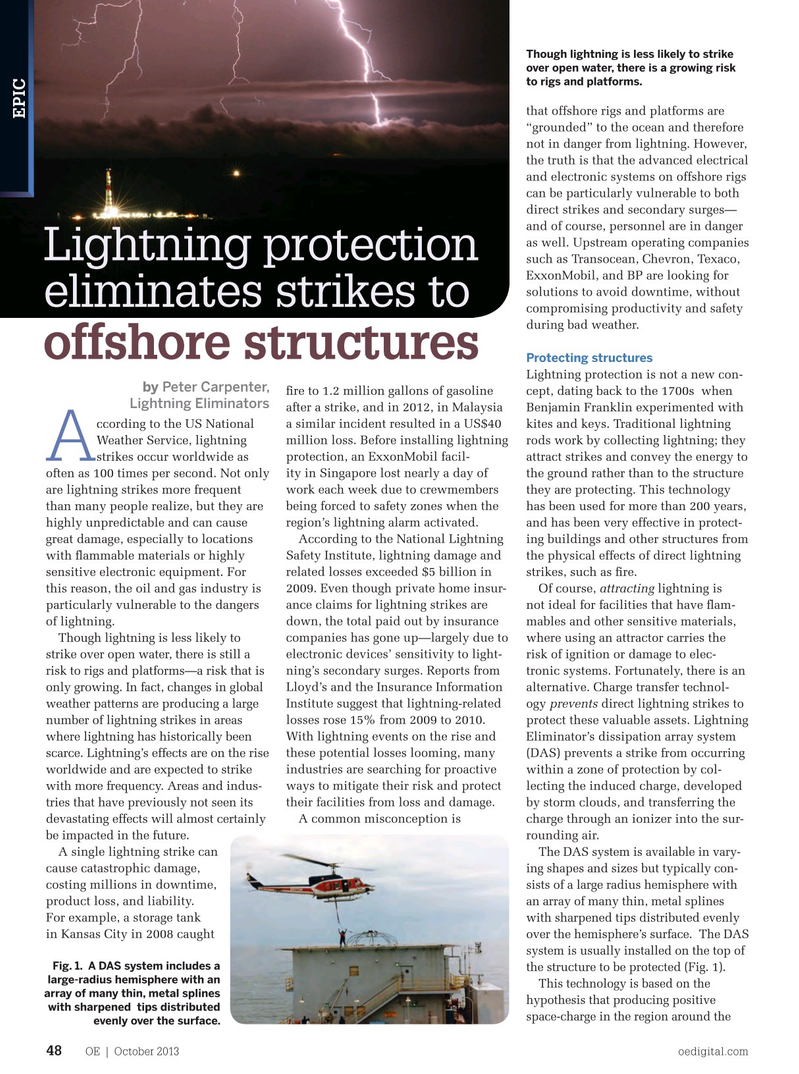
Page 46: of Offshore Engineer Magazine (Oct/Nov 2013)
Read this page in Pdf, Flash or Html5 edition of Oct/Nov 2013 Offshore Engineer Magazine
Though lightning is less likely to strike over open water, there is a growing risk to rigs and platforms. that offshore rigs and platforms are
EPIC “grounded” to the ocean and therefore not in danger from lightning. However, the truth is that the advanced electrical and electronic systems on offshore rigs can be particularly vulnerable to both direct strikes and secondary surges— and of course, personnel are in danger as well. Upstream operating companies
Lightning protection such as Transocean, Chevron, Texaco,
ExxonMobil, and BP are looking for solutions to avoid downtime, without eliminates strikes to compromising productivity and safety during bad weather.
offshore structures
Protecting structures
Lightning protection is not a new con- by Peter Carpenter, fre to 1.2 million gallons of gasoline cept, dating back to the 1700s when
Lightning Eliminators after a strike, and in 2012, in Malaysia Benjamin Franklin experimented with ccording to the US National a similar incident resulted in a US$40 kites and keys. Traditional lightning
Weather Service, lightning million loss. Before installing lightning rods work by collecting lightning; they strikes occur worldwide as protection, an ExxonMobil facil- attract strikes and convey the energy to
A often as 100 times per second. Not only ity in Singapore lost nearly a day of the ground rather than to the structure are lightning strikes more frequent work each week due to crewmembers they are protecting. This technology than many people realize, but they are being forced to safety zones when the has been used for more than 200 years, highly unpredictable and can cause region’s lightning alarm activated. and has been very effective in protect- great damage, especially to locations According to the National Lightning ing buildings and other structures from with fammable materials or highly Safety Institute, lightning damage and the physical effects of direct lightning sensitive electronic equipment. For related losses exceeded $5 billion in strikes, such as fre.
this reason, the oil and gas industry is 2009. Even though private home insur- Of course, attracting lightning is particularly vulnerable to the dangers ance claims for lightning strikes are not ideal for facilities that have fam- of lightning. down, the total paid out by insurance mables and other sensitive materials,
Though lightning is less likely to companies has gone up—largely due to where using an attractor carries the strike over open water, there is still a electronic devices’ sensitivity to light- risk of ignition or damage to elec- risk to rigs and platforms—a risk that is ning’s secondary surges. Reports from tronic systems. Fortunately, there is an only growing. In fact, changes in global Lloyd’s and the Insurance Information alternative. Charge transfer technol- weather patterns are producing a large Institute suggest that lightning-related ogy prevents direct lightning strikes to number of lightning strikes in areas losses rose 15% from 2009 to 2010. protect these valuable assets. Lightning where lightning has historically been With lightning events on the rise and Eliminator’s dissipation array system scarce. Lightning’s effects are on the rise these potential losses looming, many (DAS) prevents a strike from occurring worldwide and are expected to strike industries are searching for proactive within a zone of protection by col- with more frequency. Areas and indus- ways to mitigate their risk and protect lecting the induced charge, developed tries that have previously not seen its their facilities from loss and damage. by storm clouds, and transferring the devastating effects will almost certainly A common misconception is charge through an ionizer into the sur- be impacted in the future. rounding air.
A single lightning strike can
The DAS system is available in vary- cause catastrophic damage, ing shapes and sizes but typically con- costing millions in downtime, sists of a large radius hemisphere with product loss, and liability. an array of many thin, metal splines
For example, a storage tank with sharpened tips distributed evenly in Kansas City in 2008 caught over the hemisphere’s surface. The DAS system is usually installed on the top of
Fig. 1. A DAS system includes a the structure to be protected (Fig. 1).
large-radius hemisphere with an
This technology is based on the array of many thin, metal splines hypothesis that producing positive with sharpened tips distributed space-charge in the region around the evenly over the surface.
OE | October 2013 oedigital.com 48 048_OE1013_EPIC3_Lightning.indd 48 9/29/13 9:55 PM

 45
45

 47
47